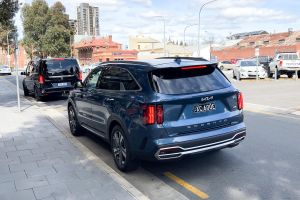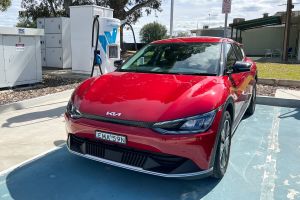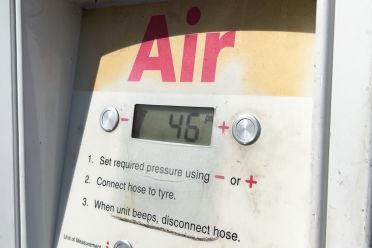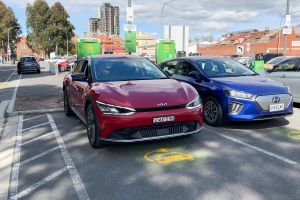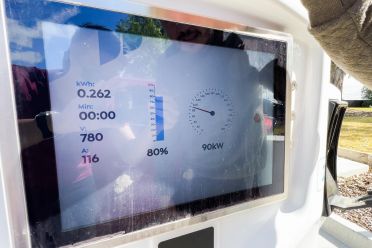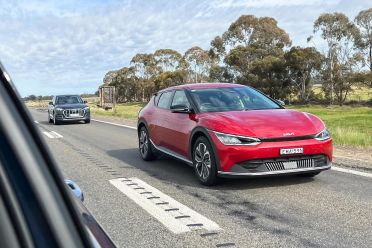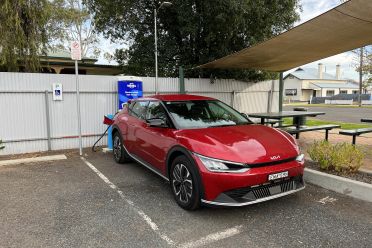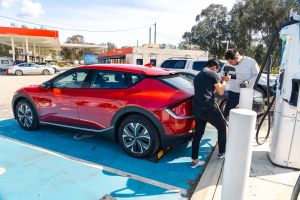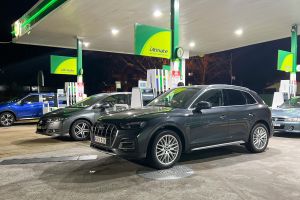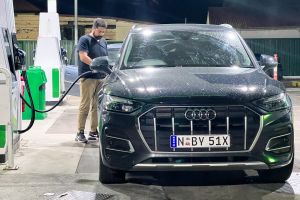We’ve all heard about how affordable EVs can become when you charge at home and take advantage of solar energy. But, what about longer distance drives? Do EVs make as much sense if you’re packing up your things to head away with the family compared to traditional modes of transport?
We wanted to put the latest EV technology to the test on a road trip from Adelaide to Sydney. We also wanted to test what EV infrastructure was like regionally and chose a route that would take us slightly inland and away from the well established charging network.
Alborz and I decided to pick a set of cars that led their field in EV tech and efficiency, so Alborz picked the entry-level Audi Q5 diesel and I picked the Kia EV6 Long Range rear-wheel drive. We then stuck our video team in the Kia Sorento Hybrid to see how that would fare on the trip as well.
And because we were making it a little less fair for the EV by doing that, we also wanted to try and achieve the entire drive (around 1400km) on a single tank of diesel to see whether it could be done.
By this point you’ll realise the test is a little contrived, and admittedly, I configured it this way because I was hoping Alborz would run out of fuel before we arrived to Sydney – preferably on the Sydney Harbour Bridge or some other equally inconvenient location.
Realistically, Alborz wouldn’t need to stress about making it 1400km on a single tank because he could fuel at any number of service stations along the way in a matter of minutes, while I’d have to wait for a full charge. And I really wanted to figure out how much time you would actually need to budget charging on this kind of trip and whether it would be enough of an inconvenience to not bother taking an EV.
But, he did take it seriously and decided he’d do around 90km/h for the trip to ensure he’d make it there on the 70 litre tank of diesel. He also upped his tyre pressure to 46psi to reduce rolling resistance.
Me on the other hand – I was going to drive normally at around the speed limit. I also used an excellent free website called A Better Route Planner to map out my trip. It takes into account topography, weather and real life energy usage at highway speeds to indicate where and when you should be charging.
Our plan was to drive all the way to Hay in New South Wales on the first day, stay overnight in a motel and then finish the drive the following day through to Sydney.
So we set off from Adelaide and brimmed both the Audi and Kia before we got started. We encountered our first challenge before we left with the bank of eight chargers in Adelaide’s CBD all full.
Well, that’s not quite true. Four of the free chargers that work in any EV were full and the four Tesla chargers directly opposite were empty (the Kia can’t charge on the Tesla network). Most frustrating was the Tesla owner who decided to use the free option instead of the Tesla charger directly opposite.
So we waited around for a while until somebody decided to leave and we plugged the EV6 up to head off.
It’s at this point we reset both trip meters to track economy as we snaked our way out of Adelaide. For those unfamiliar with Adelaide, it’s at sea level. It then climbs steeply at highway speeds. This immediately started eating into my range and affecting the electric vehicle’s economy.
The trip started off at around 17kWh/100km, but as we started making our way up the hills out of Adelaide that crept up to around 22kWh/100km.
Stop 1: Tailem Bend, South Australia (12 minute charge)
Our recommended first stop is Tailem Bend, around 132km out of Adelaide. This is a good one because the service station features 350kW fast DC chargers and the suggestion is to take the car to 95 per cent to make our next stop in Ouyen. I had to stop here for 12 minutes to charge from 80 per cent to 95 per cent.
Alborz passed me shortly after I plugged up and then I was delayed a little further after helping a couple out in their Hyundai Ioniq PHEV figure out how to create a charging account.
After leaving Tailem Bend, I jacked the speed up a bit to travel at GPS speed instead of indicated speed. This increased my economy from start to around 20kWh/100km (after it dropped to about 18kWh/100km after leaving Adelaide).
I did notice a big difference between 100km/h and 110km/h (GPS speed) in terms of energy usage. It would be the difference between it sitting more happily at the 20kWh/100km mark before creeping up to 22kWh/100km.
Stop 2: Ouyen, Victoria (1hr 14 minute charge)
We then arrived to Ouyen and I plugged the EV6 up. Unfortunately the charger in Ouyen (and as we realised through parts of regional Australia) is only a 75kW charger.
It means you need to sit here longer to charge. Being a Monday afternoon – there was also literally nothing open for food. So we just had to stand around eating junk food until the car was ready to go.
Alborz arrived midway through our charge and once he realised there was nothing open for food – he decided to leave. Thanks, Alborz.
Not wanting to let him get too far ahead – I pulled the plug at around 90 per cent and hit the road for our overnight stay in Hay.
That’s when we ran into our first hiccup. Midway between Ouyen and Hay we realised the bridge over the Murray River was closed for roadworks.
As Alborz arrived ahead of me, he had to figure out how we could get over the Murray to make it to Hay. The only easy route was a detour that added about 70km to the overall trip, but it was our only choice to make our overnight accommodation and the next charger in Hay.
As you can imagine, I started getting a little nervous at this point. Not only were we adding an unanticipated 70km to the journey, I had pulled the plug a little early to catch up with Alborz.
In addition to that the sun was setting and it was getting cold. Decreased temperature increases the amount of energy the EV needs to use to keep the battery at its optimal temperature range, which inadvertently decreases your range.
Stop 3: Hay, New South Wales (1hr 40 min charge)
I was sweating bullets as the range continuously went down faster than the distance we were travelling. The effect of this would have been multiplied even further if I had luggage and other passengers in the car.
I ended up arriving at Hay with 1% of battery remaining after having to reduce my speed to prevent the range from vanishing.
The charger in Hay is a free NRMA charger, but unfortunately it’s capped at 50kW, which means a super slow charge. Given our late arrival thankfully there was nobody else there at the only charger in town and I was able to plug up while we used our hybrid support car to go and get dinner at a truck stop.
By this point our consumption had settled to around 21kWh/100km as part of the highway drive.
So how are we going so far in terms of time spent charging. Given Hay is our overnight stay I haven’t included that time into the equation because we were able to go to the motel and eat dinner while the car was charging.
It has been a 1 hour, 30 minute deficit to the EV. Over around an 800km journey, it’s probably the amount of time I would have stopped for wee breaks and food stops if I was driving an internal combustion car, so it’s not the end of the world.
The following morning we set off for Sydney across the Hay Plains. From here the chargers all become high speed DC chargers that should mean much less time stopping for charges.
How’s Alborz doing? Up to this point he’s averaging around 4.7 litres of diesel fuel per 100km.
Stop 4: Tarcutta, New South Wales (30 minute charge)
We’re now back on the fast chargers. We plugged up at Tarcutta and juiced the EV6 from 19 per cent through to 95 per cent in around 30 minutes. It was enough time to stretch the legs and hit the road for the rest of our road trip.
Stop 5: Sutton Forrest, New South Wales (25 minute charge)
Our stop at Sutton Forrest is another 350kW charger. It was initially meant to just be an 11 minute charge, but after filming the piece to camera and going into McDonalds to get a coffee (it was busy in there), we ended up spending around 25 minutes on the charger to get us to 65 per cent.
Stop 6: Sydney, New South Wales (36 minute charge)
The final stop for Alborz and I was near to the Sydney CBD. I brimmed the EV6 to 100 per cent, which takes around 36 minutes) and Alborz fuelled the Q5, which takes about 4 minutes (it took me only 1 min! Paul counts his minutes in EV time, Alborz).
Our energy consumption in the EV6 from Sutton Forrest to Sydney was also excellent thanks to it being mainly downhill, coming in at around 14kWh/100km.
The results:
So, how did it all go?
Alborz ended up using 62.33 litres of diesel, which cost us $130.83 at a cost of $2.09 per litre.
It meant it cost him around $.092 per kilometre of travel. It also meant he consumed just under 4.3 litres of diesel per 100km.
How about the EV? Surprisingly it cost $125.56 over that journey. The EV6 is also travelled a slightly shorter distance due to Alborz needing to investigate our detour.
The other thing worth pointing out as well is that we had to pay to charge at every one of our charge stops except the big charge at Hay near our accommodation. If we had to pay for the charge in Hay, the EV would have actually cost more for the same trip.
And the inconvenience? If you exclude our overnight stop at Hay, the EV6 had to stop for a total of just under three hours over 1400km. Given the recommendation is to stop every 200km for a break, that almost equals out to the recommendation.
In addition to that, if we had taken the more popular route, it would have been littered with fast chargers that would have significantly dropped our wait times.
Anyway – we hope you enjoyed this challenge. Like I mentioned in the intro, this wasn’t a scientific test by any means. It was more designed primarily for Alborz to run out of fuel, but secondly to see just how inconvenient an EV is over a long distance regional drive. We hope you enjoyed it.

